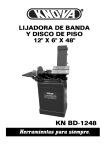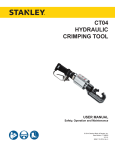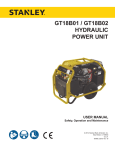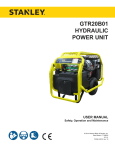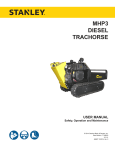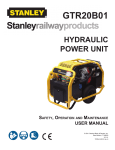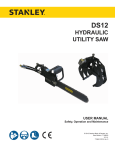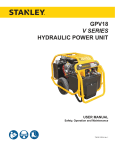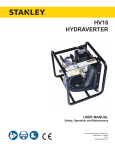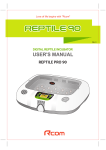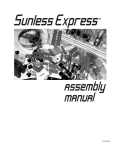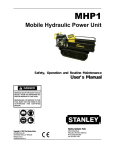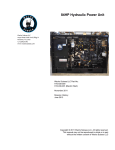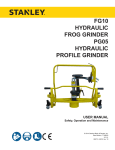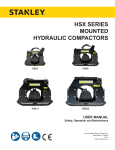Download HP TWIN8 User Manual 4-2015 V9
Transcript
HYDRAULIC POWER UNIT USER MANUAL Safety, Operation and Maintenance © 2013 Stanley Black & Decker, Inc. New Britain, CT 06053 U.S.A. 72464 4/2015 Ver. 9 2 ► HP TWIN8 User Manual TABLE OF CONTENTS SAFETY SYMBOLS...................................................................................................................................................4 SAFETY PRECAUTIONS...........................................................................................................................................5 TOOL STICKERS.......................................................................................................................................................7 HOSE TYPES.............................................................................................................................................................8 HOSE RECOMMENDATIONS...................................................................................................................................9 HTMA \ EHTMA REQUIREMENTS..........................................................................................................................10 PRE-OPERATION.................................................................................................................................................... 11 CONTROLS..............................................................................................................................................................12 START-UP................................................................................................................................................................12 MAINTENANCE.......................................................................................................................................................13 BATTERY MAINTENANCE................................................................................................................................13 CIRCUIT TESTING..................................................................................................................................................16 TROUBLESHOOTING.............................................................................................................................................17 SPECIFICATIONS....................................................................................................................................................18 ACCESSORIES.......................................................................................................................................................19 LOWER FRAME ILLUSTRATION............................................................................................................................20 LOWER FRAME PARTS LIST.................................................................................................................................21 HYDRAULIC GROUP ILLUSTRATION....................................................................................................................22 HYDRAULIC GROUP PARTS LIST.........................................................................................................................23 UPPER FRAME ILLUSTRATION AND PARTS LIST...............................................................................................24 HYDRAULIC FLOW.................................................................................................................................................25 CONTROL BLOCK DETAIL......................................................................................................................................26 HYDRAULIC & FUEL TANKS...................................................................................................................................27 IMPORTANT To fill out a Product Warranty Validation form, and for information on your warranty, visit Stanleyhydraulics.com and select the Company tab, Warranty. (NOTE: The warranty Validation record must be submitted to validate the warranty). SERVICING: This manual contains safety, operation, and routine maintenance instructions. Stanley Hydraulic Tools recommends that servicing of hydraulic tools, other than routine maintenance, must be performed by an authorized and certified dealer. Please read the following warning. WARNING SERIOUS INJURY OR DEATH COULD RESULT FROM THE IMPROPER REPAIR OR SERVICE OF THIS TOOL. REPAIRS AND / OR SERVICE TO THIS TOOL MUST ONLY BE DONE BY AN AUTHORIZED AND CERTIFIED DEALER. For the nearest authorized and certified dealer, call Stanley Hydraulic Tools at (503) 659-5660 and ask for a Customer Service Representative. HP TWIN8 User Manual ◄ 3 SAFETY SYMBOLS Safety symbols and signal words, as shown below, are used to emphasize all operator, maintenance and repair actions which, if not strictly followed, could result in a life-threatening situation, bodily injury or damage to equipment. This is the safety alert symbol. It is used to alert you to potential personal injury hazards. Obey all safety messages that follow this symbol to avoid possible injury or death. DANGER This safety alert and signal word indicate an imminently hazardous situation which, if not avoided, will result in death or serious injury. WARNING This safety alert and signal word indicate a potentially hazardous situation which, if not avoided, could result in death or serious injury. CAUTION This safety alert and signal word indicate a potentially hazardous situation which, if not avoided, could result in death or serious injury. CAUTION This signal word indicates a potentially hazardous situation which, if not avoided, may result in property damage. NOTICE This signal word indicates a situation which, if not avoided, will result in damage to the equipment. IMPORTANT This signal word indicates a situation which, if not avoided, may result in damage to the equipment. Always observe safety symbols. They are included for your safety and for the protection of the tool. LOCAL SAFETY REGULATIONS Enter any local safety regulations here. Keep these instructions in an area accessible to the operator and maintenance personnel. 4 ► HP TWIN8 User Manual SAFETY PRECAUTIONS Tool operators and maintenance personnel must always comply with the safety precautions given in this manual and on the stickers and tags attached to the tool and hose. • Do not inspect hoses and fittings for leaks by using bare hands. “Pin-hole” leaks can penetrate the skin. • NEVER OPERATE THE POWER UNIT IN A CLOSED SPACE. Inhalation of engine exhaust can be fatal. • Do not operate a damaged, improperly adjusted power unit. • Do not wear loose clothing or unbound long hair when operating the tool. Loose items can get entangled with the tool and cause serious injury. • Keep all parts of your body away from the working parts of the power unit. • Keep clear of hot engine exhaust. • Do not add fuel to the power unit while the power unit is running or is still hot. • Do not operate the power unit if gasoline odor is present. • Do not use flammable solvents around the power unit engine. • Do not operate the power unit within 3.3 ft/1 m of buildings, obstructions or flammable objects. • Do not reverse tool rotation direction by changing fluid flow direction. • Establish a training program for all operators to ensure safe operation. Allow power unit engine to cool before storing in an enclosed space. • Do not operate the power unit unless thoroughly trained or under the supervision of an instructor. Always keep critical tool markings, such as labels and warning stickers legible. • • Always wear safety equipment such as goggles, ear protection, breathing protection, head protection, and safety shoes at all times when operating the power unit and a hydraulic tool. To avoid personal injury or equipment damage, all tool repair, maintenance and service must only be performed by authorized and properly trained personnel. • • Do not inspect or clean the power unit while it is running. Accidental engagement of the unit can cause serious injury. Do not operate the machine on excessive slopes or unstable terrain where “tip over” is a hazard. • Always use hoses and fittings rated at 2500 psi/172 bar with a 4 to 1 safety factor. Be sure all hose connections are tight. Do not exceed the rated limits of the equipment or use the equipment for applications beyond its design capacity. • Be aware of surrounding hazards. Noise created by the Power Unit and the tools it operates may mask early indications of approaching hazards. These safety precautions are given for your safety. Review them carefully before operating the tool and before performing general maintenance or repairs. Supervising personnel should develop additional precautions relating to the specific work area and local safety regulations. If so, place the added precautions in the space provided in this manual. The HP TWIN8 Hydraulic Power Unit will provide safe and dependable service if operated in accordance with the instructions given in this manual. Read and understand this manual and any stickers and tags attached to the tool and hoses before operation. Failure to do so could result in personal injury or equipment damage. • • • • • Operator must start in a work area without bystanders. The operator must be familiar with all prohibited work areas such as excessive slopes and dangerous terrain conditions. Be sure all hoses are connected for correct flow direction to and from the tool being used. HP TWIN8 User Manual ◄ 5 SAFETY PRECAUTIONS • Warning: Hydraulic fluid under pressure could cause skin injection injury. If you are injured by hydraulic fluid, get medical attention immediately. • Be observant of the hydraulic hoses lying about the work area, they can be a tripping hazard. • Use proper lifting techniques when handling the power unit, and do not over-reach. • Only use the Power Unit in well-ventilated areas. DO NOT operate in explosive atmospheres, in closed environments or near flammable substances. • Always be well-rested and mentally alert when operating the Power Unit and tools. DO NOT operate if affected by medications, drugs or alcohol. • Keep clear of hot (engine) parts and exhaust. • Do not operate tools if oil temperature exceeds 140 °F/60 °C. Operation at high temperatures can cause higher than normal temperatures at the tools which can result in operator discomfort or injury. • Disconnect battery before servicing electrical components. Electrocution or burns could result from improper contact. • Loading and unloading of the power unit is dangerous. Never attempt to load or unload the power unit without loading ramps, loading dock or an over head crane. Loading ramps must be strong enough, have a low angle, and correct height. Load and unload the power unit on a level surface. Never attempt to load or unload the power unit if the ramp incline exceeds 15 degrees. Failure to follow these instructions may result in serious injury or death. • Warning: Use of this tool on certain materials during demolition could generate dust potentially containing a variety of hazardous substances such as asbestos, silica or lead. Inhalation of dust containing these or other hazardous substances could result in serious injury, cancer or death. Protect yourself and those around you. Research and understand the materials you are cutting. Follow correct safety procedures and comply with all applicable national, state or provisional health and safety regulations relating to them, including, if appropriate arranging for the safe disposal of the materials by a qualified person. 6 ► HP TWIN8 User Manual TOOL STICKERS LOGO, TWIN8 DECAL P/N-205044 DASH, TWIN8, DECAL P/N-205043 STANLEY, HYD TANK, DECAL P/N-205049 LOGO TWIN8, HYD TANK DECAL P/N-205046 STANLEY, FUEL TANK DECAL P/N-205048 LOGO, TWIN8, FUEL TANK DECAL P/N-205045 SAFETY, TWIN8, DECAL P/N-205047 HP TWIN8 User Manual ◄ 7 HOSE TYPES The rated working pressure of the hydraulic hose must be equal to or higher than the relief valve setting on the hydraulic system. There are three types of hydraulic hose that meet this requirement and are authorized for use with Stanley Hydraulic Tools. They are: Certified non-conductive — constructed of thermoplastic or synthetic rubber inner tube, synthetic fiber braid reinforcement, and weather resistant thermoplastic or synthetic rubber cover. Hose labeled certified nonconductive is the only hose authorized for use near electrical conductors. Wire-braided (conductive) — constructed of synthetic rubber inner tube, single or double wire braid reinforcement, and weather resistant synthetic rubber cover. This hose is conductive and must never be used near electrical conductors. Fabric-braided (not certified or labeled non-conductive) — constructed of thermoplastic or synthetic rubber inner tube, synthetic fiber braid reinforcement, and weather resistant thermoplastic or synthetic rubber cover. This hose is not certified non-conductive and must never be used near electrical conductors. HOSE SAFETY TAGS To help ensure your safety, the following DANGER tags are attached to all hose purchased from Stanley Hydraulic Tools. DO NOT REMOVE THESE TAGS. If the information on a tag is illegible because of wear or damage, replace the tag immediately. A new tag may be obtained from your Stanley Distributor. D A N G E R D A N G E R 1. FAILURE TO USE HYDRAULIC HOSE LABELED AND CERTIFIED AS NON-CONDUCTIVE WHEN USING HYDRAULIC TOOLS ON OR NEAR ELECTRIC LINES MAY RESULT IN DEATH OR SERIOUS INJURY. FOR PROPER AND SAFE OPERATION MAKE SURE THAT YOU HAVE BEEN PROPERLY TRAINED IN CORRECT PROCEDURES REQUIRED FOR WORK ON OR AROUND ELECTRIC LINES. 2. BEFORE USING HYDRAULIC HOSE LABELED AND CERTIFIED AS NON-CONDUCTIVE ON OR NEAR ELECTRIC LINES. WIPE THE ENTIRE LENGTH OF THE HOSE AND FITTING WITH A CLEAN DRY ABSORBENT CLOTH TO REMOVE DIRT AND MOISTURE AND TEST HOSE FOR MAXIMUM ALLOWABLE CURRENT LEAKAGE IN ACCORDANCE WITH SAFETY DEPARTMENT INSTRUCTIONS. 3. DO NOT EXCEED HOSE WORKING PRESSURE OR ABUSE HOSE. IMPROPER USE OR HANDLING OF HOSE COULD RESULT IN BURST OR OTHER HOSE FAILURE. KEEP HOSE AS FAR AWAY AS POSSIBLE FROM BODY AND DO NOT PERMIT DIRECT CONTACT DURING USE. CONTACT AT THE BURST CAN CAUSE BODILY INJECTION AND SEVERE PERSONAL INJURY. 4. HANDLE AND ROUTE HOSE CAREFULLY TO AVOID KINKING, ABRASION, CUTTING, OR CONTACT WITH HIGH TEMPERATURE SURFACES. DO NOT USE IF KINKED. DO NOT USE HOSE TO PULL OR LIFT TOOLS, POWER UNITS, ETC. 5. CHECK ENTIRE HOSE FOR CUTS CRACKS LEAKS ABRASIONS, BULGES, OR DAMAGE TO COUPLINGS IF ANY OF THESE CONDITIONS EXIST, REPLACE THE HOSE IMMEDIATELY. NEVER USE TAPE OR ANY DEVICE TO ATTEMPT TO MEND THE HOSE. 6. AFTER EACH USE STORE IN A CLEAN DRY AREA. SEE OTHER SIDE SIDE 1 SEE OTHER SIDE (Shown smaller than actual size) DO NOT REMOVE THIS TAG DO NOT REMOVE THIS TAG THE TAG SHOWN BELOW IS ATTACHED TO “CERTIFIED NON-CONDUCTIVE” HOSE SIDE 2 D A N G E R D A N G E R 1. DO NOT USE THIS HYDRAULIC HOSE ON OR NEAR ELECTRIC LINES. THIS HOSE IS NOT LABELED OR CERTIFIED AS NON-CONDUCTIVE. USING THIS HOSE ON OR NEAR ELECTRICAL LINES MAY RESULT IN DEATH OR SERIOUS INJURY. 5. CHECK ENTIRE HOSE FOR CUTS CRACKS LEAKS ABRASIONS, BULGES, OR DAMAGE TO COUPLINGS IF ANY OF THESE CONDITIONS EXIST, REPLACE THE HOSE IMMEDIATELY. NEVER USE TAPE OR ANY DEVICE TO ATTEMPT TO MEND THE HOSE. 2. FOR PROPER AND SAFE OPERATION MAKE SURE THAT YOU HAVE BEEN PROPERLY TRAINED IN CORRECT PROCEDURES REQUIRED FOR WORK ON OR AROUND ELECTRIC LINES. 6. AFTER EACH USE STORE IN A CLEAN DRY AREA. 3. DO NOT EXCEED HOSE WORKING PRESSURE OR ABUSE HOSE. IMPROPER USE OR HANDLING OF HOSE COULD RESULT IN BURST OR OTHER HOSE FAILURE. KEEP HOSE AS FAR AWAY AS POSSIBLE FROM BODY AND DO NOT PERMIT DIRECT CONTACT DURING USE. CONTACT AT THE BURST CAN CAUSE BODILY INJECTION AND SEVERE PERSONAL INJURY. 4. HANDLE AND ROUTE HOSE CAREFULLY TO AVOID KINKING, CUTTING, OR CONTACT WITH HIGH TEMPERATURE SURFACES. DO NOT USE IF KINKED. DO NOT USE HOSE TO PULL OR LIFT TOOLS, POWER UNITS, ETC. SEE OTHER SIDE SEE OTHER SIDE SIDE 1 SIDE 2 (Shown smaller than actual size) 8 ► HP TWIN8 User Manual DO NOT REMOVE THIS TAG DO NOT REMOVE THIS TAG THE TAG SHOWN BELOW IS ATTACHED TO “CONDUCTIVE” HOSE. All hydraulic hose must meet or exceed specifications as set forth by SAE J517. All hydraulic hose must have at least a rated minimum working pressure equal to the maximum hydraulic system relief valve setting. This chart is intended to be used for hydraulic tool applications only based on Stanley Hydraulic Tools tool operating requirements and should not be used for any other applications. The chart to the right shows recommended minimum hose diameters for various hose lengths based on gallons per minute (gpm)/ liters per minute (lpm). These recommendations are intended to keep return line pressure (back pressure) to a minimum acceptable level to ensure maximum tool performance. Tool to Hydraulic Circuit Hose Recommendations 15-34 MM Inside Diameter INCH USE (Press/Return) PSI up to 10 up to 3 3/8 10 Both 2250 49-60 13-16 FLOW >>> RETURN <<< FLOW PRESSURE 26-100 up to 25 100-200 51-100 up to 50 100-300 51-100 up to 50 26-100 up to 25 8-30 up to 8 30-60 15-30 up to 15 30-90 15-30 up to 15 7.5-30 up to 7.5 19 25.4 16 19 19 25.4 5/8 3/4 3/4 1 19 3/4 1 16 3/4 16 19 3/4 5/8 16 5/8 5/8 16 13 13 10 5/8 1/2 1/2 3/8 175 175 175 175 175 175 175 175 175 175 175 175 175 175 175 2500 2500 2500 2500 2500 2500 2500 2500 2500 2500 2500 2500 2500 2500 2500 Both Both Both Both Pressure Return Both Pressure Return Pressure Return Pressure Return Pressure Return PRESSURE Figure 1. Typical Hose Connections 49-60 38-49 10-13 13-16 19-40 5-10.5 38-49 19-40 5-10.5 10-13 19-40 5-10.5 38-49 15-23 10-13 15-23 4-6 155 BAR Min. Working Pressure Certified Non-Conductive Hose - Fiber Braid - for Utility Bucket Trucks METERS Hose Lengths FEET Conductive Hose - Wire Braid or Fiber Braid -DO NOT USE NEAR ELECTRICAL CONDUCTORS 4-6 4-9 LPM Oil Flow GPM HOSE RECOMMENDATIONS HYDRAULIC CIRCUIT RETURN HP TWIN8 User Manual ◄ 9 HTMA / EHTMA REQUIREMENTS HTMA / EHTMA REQUIREMENTS HTMA HYDRAULIC SYSTEM REQUIREMENTS TYPE I Nominal Operating Pressure (at the power supply outlet) 4-6 gpm (15-23 lpm) 1500 psi (103 bar) TOOL TYPE TYPE II TYPE RR 7-9 gpm (26-34 lpm) 1500 psi (103 bar) 9-10.5 gpm (34-40 lpm) 1500 psi (103 bar) System relief valve setting (at the power supply outlet) 2100-2250 psi (145-155 bar) 2100-2250 psi (145-155 bar) 2200-2300 psi (152-159 bar) 2100-2250 psi (145-155 bar) Maximum back pressure (at tool end of the return hose) 250 psi (17 bar) 250 psi (17 bar) 250 psi (17 bar) 250 psi (17 bar) Measured at a max. fluid viscosity of: (at min. operating temperature) 400 ssu* 400 ssu* 400 ssu* 400 ssu* (82 centistokes) (82 centistokes) (82 centistokes) (82 centistokes) Temperature: Sufficient heat rejection capacity to limit max. fluid temperature to: (at max. expected ambient temperature) 140° F (60° C) Flow Range 140° F (60° C) 140° F (60° C) TYPE III 11-13 gpm (42-49 lpm) 1500 psi (103 bar) 140° F (60° C) 3 hp 5 hp 6 hp 7 hp Min. cooling capacity at a temperature (2.24 kW) (3.73 kW) (5.22 kW) (4.47 kW) difference of between ambient and fluid 40° F 40° F 40° F 40° F temps (22° C) (22° C) (22° C) (22° C) NOTE: Do not operate the tool at oil temperatures above 140° F (60° C). Operation at higher temperatures can cause operator discomfort at the tool. Filter Min. full-flow filtration Sized for flow of at least: (For cold temp. startup and max. dirt-holding capacity) 25 microns 30 gpm (114 lpm) Hydraulic fluid Petroleum based (premium grade, anti-wear, non-conductive) Viscosity (at min. and max. operating temps) 100-400 ssu* 25 microns 30 gpm (114 lpm) 25 microns 30 gpm (114 lpm) 100-400 ssu* 100-400 ssu* (20-82 centistokes) 25 microns 30 gpm (114 lpm) 100-400 ssu* NOTE: When choosing hydraulic fluid, the expected oil temperature extremes that will be experienced in service determine the most suitable temperature viscosity characteristics. Hydraulic fluids with a viscosity index over 140 will meet the requirements over a wide range of operating temperatures. *SSU = Saybolt Seconds Universal EHTMA HYDRAULIC SYSTEM REQUIREMENTS CLASSIFICATION B C D Nominal Operating Pressure (at the power supply outlet) 3.5-4.3 gpm (13.5-16.5 lpm) 1870 psi (129 bar) 4.7-5.8 gpm (18-22 lpm) 1500 psi (103 bar) 7.1-8.7 gpm (27-33 lpm) 1500 psi (103 bar) 9.5-11.6 gpm (36-44 lpm) 1500 psi (103 bar) 11.8-14.5 gpm (45-55 lpm) 1500 psi (103 bar) System relief valve setting (at the power supply outlet) 2495 psi (172 bar) 2000 psi (138 bar) 2000 psi (138 bar) 2000 psi (138 bar) 2000 psi (138 bar) Flow Range NOTE: These are general hydraulic system requirements. See tool specification page for tool specific requirements 10 ► HP TWIN8 User Manual PRE-OPERATION PREPARATION FOR USE Do not operate the power unit until you have read the engine operating and maintenance instructions manual furnished with the unit. 1. ENGINE CRANKCASE OIL LEVEL Always check the oil level before starting the engine. Make sure the oil level is at the FULL MARK on the dipstick. Do not overfill. Use detergent oil classified “For Service SF, SG, SH, SJ or higher” as specified in the engine operators manual. Do not use special additives. Outdoor temperatures determine the proper oil viscosity for the engine. Use the chart to select the best viscosity for the outdoor temperature range expected. °C 104 40 86 30 14 HTMA-approved quick disconnect couplings are installed to hydraulic hoses so that the direction of oil flow is always from the male to the female quick disconnect as shown on page 9. Quick disconnect couplings and hose fittings are selected so that additional fittings such as reducer or adapter fittings are not required. If adapter fittings are used, they must be approved steel hydraulic fittings meeting a minimum operating pressure rating of 2500 psi/172 bar. Do not use galvanized pipe fittings or black pipe fittings. Use thread tape or pipe joint compound when installing quick disconnect couplings to hose or tool fittings. Follow the instructions furnished with the selected thread sealant. DO NOT OVERTIGHTEN THE FITTINGS. 3. HYDRAULIC FLUID 10 5W-30 32 Synthetic 5W-30 50 20 10W-30 ** 68 SAE 30 * °F QUICK DISCONNECT COUPLERS 0 RECOMMENDED HYDRAULIC OILS -10 Below is a list of recommended oils by brand. Biodegradable Description CITGO No Hydurance AW32 AMS Oil No HVH 32 Exxon Mobil No Univis HVI26* * Below 40°F (4°C) the use of SAE 30 will result in hard starting. Exxon Mobil No DTE 10 Excel Shell No S2 V 32 ** Above 80°F (27°C) the use of 10W-30 may cause increased oil consumption. Check oil level more frequently. Chevron No Rando HDZ 32 Conoco Phillips No Unax AW-WR-32 Clarion (CITGO) Yes Green Bio 32 Exxon Mobil Yes EAL 224H Chevron Yes Clarity AW32 Terresolve Yes Envirologic 132 Shell Yes Naturelle HF-E-32 -4 -22 Brand -20 -30 2. ENGINE FUEL LEVEL Check the fuel level. If low, fill with clean, fresh unleaded gasoline with a minimum of 87 octane. Gasoline with up to 10% ethanol (gasohol) is acceptable. *Recommended for extreme cold temperatures 3. HYDRAULIC CONNECTIONS The recommended hose length is 25 ft/8 m with a 1/2 inch/12.7 mm inside diameter. The hoses must have a working pressure rating of at least 2500 psi/175 bar. Each hose end must have male thread ends compatible with HTMA (HYDRAULIC TOOL MANUFACTURERS ASSOCIATION) quick disconnect fittings (NPT type threads). (See pages 8 and 9). HP TWIN8 User Manual ◄ 11 OPERATION CONTROLS (DUAL CIRCUIT) 5. BATTERY The supplied 12-Volt DC battery is a sealed nonspillable, maintenance-free battery and is fully charged. Throttle Control Lever Starter Switch Make sure the battery cables are tight and charging circuit functions are operating properly. NOTICE A fully charged battery should read 12.8V -13.0V. Caution, overcharging can harm your battery beyond recovery. When using an automatic charger, refer to the charger manufacturer’s instructions. Flow Control Lever(s) In Off Position NOTICE If the engine runs out of gas or dies during operation and the ignition switch is left in the ON or RUN position, this could drain the battery. Make sure the ignition switch is returned to the OFF position. When the throttle control lever is in the far left position, it will produce 5 GPM to both circuits at the same time and with the lever in the far right position will produce 8 GPM to both circuits. This allows two tools that can run simultaneously at 5 or 8 GPM. The flow control levers when turned “ON” (up position) turns on flow to the tool or tools depending on if you are using one or both circuits. STARTUP COUPLERS (HOSE CONNECTIONS) Top Male Quick Disconnect Couplers (Pressure Fluid Out) 1. Before starting the engine check the engine oil and hydraulic fluid level. 2. Check to make sure the flow Control levers are in the OFF position (Down), the power unit will not start if the levers are in the “UP” position (ON). 3. Connect hoses and the tool as described on page 9. 4. It is not necessary to choke the engine, it is equipped with a “Electronic Fuel Management System” that does not have a manual choke. 5. Set the throttle control lever to the left (5-GPM) setting. Once the unit starts and is warmed-up the lever can be moved to the 8-GPM setting if desired. 6. Turn the Ignition Switch to the START position. After the engine starts, release the switch. Bottom Female Quick Disconnect Couplers (Return Fluid In) Facing the control panel, the top (2) male couplers are the PRESSURE FLUID OUT fittings. The bottom (2) female quick disconnect couplers are the RETURN FLUID IN. Their are two independent circuits, one on the left and one on the right, each controlled by the adjacent lever. 12 ► HP TWIN8 User Manual 7. Allow the engine to warm up. 8. Turn on the flow to the tool by lifting the “Flow Control Levers” up into the on position, lift both levers if running two circuits (two Tools). SHUTDOWN 1. Ensure the flow control levers are in the OFF position (Down). 2. Move the Ignition Switch to the OFF position. MAINTENANCE COLD WEATHER STARTUP 1. Use the procedures described under “STARTUP” and then follow the procedure below. 2. Hydraulic fluids are thicker in cold weather. Therefore, it is recommended that the engine be run at low idle long enough to bring the fluid temperature up to a minimum of 50 °F/10 °C. 3. If the tools and tool hoses are cold, it is recommended to allow hydraulic fluid to circulate through the tool hoses until warm before using the tool. ENGINE MAINTENANCE Follow the maintenance schedule and general maintenance instructions and emissions control maintenance in the engine operators manual furnished with the power unit. Fuel system emissions maintenance: • Check the fuel system emissions components once a year to verify that the components are in good condition and do not show signs of leakage. If leakage is found, replace part. • Check fuel lines, tank, cap and fittings frequently for cracks or leaks. Replace if necessary. • Clean the fuel cap area of dirt and debris. • Replacement parts must be the same and installed in the same position as the original parts. • Change the hydraulic filter element every 200 hours of operation. Change more often if cold, moist or dusty conditions exist. • Check oil cooler for debris. Remove debris with air pressure. BATTERY MAINTENANCE • If the power unit is not in use for two or more months, check the battery once a month and charge if the battery voltage is below 12.5V. Charge at 1.3A for 5-10 hours. • If the battery voltage is below 12.0V, charge at 1.3A for 12-18 hours, let the battery sit for 1-2 hours and check the voltage. If the voltage is not 12.5V or greater, replace the battery. • Always charge using a charger as rated as close to 1.3A as possible. • Checking battery voltage and charging can be done through the 12V marine plug on the battery cover when using an appropriate adapter. STORAGE • Clean the unit thoroughly before storage. Do not use water pressure. • Always store the unit in a clean and dry facility. • If the unit will be stored for a prolonged period (over 30 days), add a fuel additive to the fuel tank to prevent the fuel from gumming. Run engine for 2 minutes to circulate the additive throughout the fuel system. HYDRAULIC SYSTEM MAINTENANCE • • Check hydraulic fluid level daily. Add fluid per specifications in this manual. (See “HYDRAULIC FLUID” under the section titled “PRE-OPERATION” page 11. Remove condensed moisture from the hydraulic fluid by pumping the hydraulic fluid into a 5 gal/20 L. container through the pressure hose. Make sure the engine is at idle when performing this procedure. When the hydraulic reservoir is empty turn the engine off immediately. • Allow the fluid to sit long enough for the water to settle to the bottom of the container. Slowly pour the fluid back into the hydraulic tank, avoiding the water at the bottom of the container. • Each day, check hydraulic lines and fittings for leaks, kinks, etc. Do not use your hand to perform this check. WARNING When storing fuel or equipment with fuel in the tank, store away from appliances that have pilot lights or other ignition sources, they can ignite fuel vapors. • Replace crankcase oil with new oil. • Remove spark plugs and pour approximately 1 ounce (30 ml) of engine oil into each cylinder. Replace spark plugs and crank the engine slowly to distribute the oil. • Check hydraulic reservoir for water. If water is found, change the oil and circulate it through the tool hose and tool. (See “HYDRAULIC SYSTEM MAINTENANCE” earlier in this section). • Disconnect tool hoses. HP TWIN8 User Manual ◄ 13 MAINTENANCE Standard Maintenance Schedule Hours Daily 5 25 50 75 100 125 150 175 200 Foam Air Pre-Cleaner C I I R I I I R Paper Air Filter C R R R Engine Inline Fuel Filter R Spark Plugs (Gap-0.030 in (0.76 mm) R Engine Oil Filter R R R R R Engine Oil R R R R R Engine Oil Level I Remove Dirt & Debris With Brush I C Clean Air Cooling System (don’t use water) C I Hydraulic Fluid Level R Hydraulics Hydraulic Fluid R Remove Condensed Moisture R I Check For Leaks, Kinks, etc. I Hydraulic Fluid Filter I I R C Clean Hydraulic Fluid Cooler I Relief Valve Settings C I I I Heavy Duty Maintenance Schedule Hours Daily 5 25 50 75 100 125 150 175 200 Foam Air Pre-Cleaner C* R I R I R I R Paper Air Filter C* R R R R R Engine Inline Fuel Filter R Spark Plugs (Gap-0.030 in (0.76 mm) Engine Oil Filter Engine Oil Engine Oil Level I Remove Dirt & Debris With Brush I Hydraulic Fluid Level R R R R R R R R R R R R R R R R R R C C R Hydraulics Remove Condensed Moisture Relief Valve Settings R R R R I R I R C C C C I I I I I Hydraulic Fluid Filter Clean Hydraulic Fluid Cooler C I Hydraulic Fluid Check For Leaks, Kinks, etc. R R C Clean Air Cooling System (don’t use water) R ** C Clean (* In dusty conditions or when airborne debris is present, clean more often). I Inspect (** In dusty conditions or when airborne debris is present, inspect the back side of cooler often). R Replace For additional maintenance information see the Briggs & Stratton engine operator’s manual that was supplied with the power unit. 14 ► HP TWIN8 User Manual MAINTENANCE FUEL FILTER, FUEL LINE FROM TANK TO FILTER “GG” CONNECTION See Page 27 SEE PAGE 19 FOR REPLACEMENT FILTER PART NUMBERS ENGINE OIL COOLER HYDRAULIC OIL FILTER HYDRAULIC FUEL LINE FROM TANK TO FUEL PUMP TANK THROTTLE CABLE FUEL VAPOR LINE FROM CARBON CANISTER TO ENGINE (CONNECTION “HH”) See Page 27 ENGINE OIL CHECK & FILL (DIP STICK) FUEL TANK QUICK ENGINE OIL DRAIN AIR CLEANER SPARK PLUG HYDRAULIC OIL COOLER HP TWIN8 User Manual ◄ 15 CIRCUIT TESTING GENERAL Tests and adjustments should be performed periodically to ensure the power unit is operating at maximum efficiency. Use a calibrated flow and pressure tester. This tester can be used to isolate problems in both the engine and hydraulic system prior to any power unit disassembly. TESTING THE HYDRAULIC CIRCUIT The following tests can be performed to ensure that the hydraulic pump is supplying the correct flow and pressure and that the system relief valve is operating properly. During these tests, make sure the engine is warm and operating smoothly. If test results are not as specified, refer to the troubleshooting table in this section for possible causes. TESTING THE 5 OR 8 GPM CIRCUIT To test the circuit, proceed as follows: Throttle Control Lever 4. Check that the tester restrictor valve is fully open (counterclockwise) on the flow and pressure tester. 5. Start the engine and allow it to run until warm. 6. With the throttle control in the far left position, the (5-GPM) circuit can be tested, or moving the lever to the far right will allow testing the (8-GPM) circuit. a. 5-GPM Range 4-6 gpm/15-23 lpm b. 8-GPM Range 7-9 gpm/26.5-34 lpm 7. Slowly turn the restrictor valve clockwise while watching the pressure gauge. The flow rate shown above in step 6 should stay at the selected flow range. 8. When the pressure reaches 2100–2200 psi/145– 152 bar, the relief valve should begin to open. The pressure at which the relief valve just begins to open is commonly referred to as the “cracking pressure”. At the “cracking pressure,” the flow rate should start to drop because the relief valve is allowing fluid to bypass to the hydraulic reservoir. The “cracking pressure” is preset at the factory and if it is not within the above range (2100-2200) psi, the relief valve must be re-set as follows: The relief valves are located on the control block which is directly behind the couplers on the dash panel (See item 10, pg-22) for location. Use a wrench to loosen the nut on the relief valve. 9. Use an Allen wrench to adjust the relief valve. Turn clockwise to raise the pressure and counterclockwise to reduce the pressure. Tighten the nut and retest. 10. Check both the 5 and 8 gallon flow settings and then follow the same procedure to test the other circuit (each circuit has its own relief valve). Flow Control Lever(s) 1. Install a calibrated flow and pressure tester across the two hose ends (where the tool would normally be connected). 2. Set both flow control levers to the OFF (down) position. 3. Set the throttle control lever to the far left for 5 GPM, after the engine is started you can leave the lever in this position if you are testing the 5 GPM circuit or move the lever to the far right to test the 8 GPM circuit. 16 ► HP TWIN8 User Manual TROUBLESHOOTING Problem Engine will not start Cause Solution Battery not connected. Attach battery cables, check wires. Weak battery. Test battery, charge or replace. No fuel. Add fuel. Fuel filter plugged. Replace fuel filter. Defective spark plugs. Remove plugs, check gap, clean or replace. Low Engine Oil Check Oil Level Flow Control Levers in the “ON” position. Move the levers to the off position. Fluid blowing out of fluid reservoir vent. Hydraulic tank overfilled. Correct the fluid level. Pump suction leak. Check suction connections. Tighten if necessary. Hydraulic tool won’t operate. Flow control lever(s) not in the (ON) Check that the flow control lever(s) position. are in the ON position. Incorrect hose connection to tool. Make sure the tool hose circuit goes from left (pressure) fitting to tool and back to the right fitting (return). Fluid always flows from the male to female fittings. Quick disconnect fittings defective. Detach from hose, connect set together and check for free flow. Hydraulic fluid level low. Check for correct fluid level. Fill using the recommended fluid. Relief valve stuck open. Adjust or replace valve. Suction hose kinked. Make sure suction hose from fluid reservoir to pump inlet has a smooth curve. Tool is defective. Refer to tool manual. HP TWIN8 User Manual ◄ 17 SPECIFICATIONS HP TWIN8 SPECIFICATIONS Engine:.............................................................................................................. 27 hp OHV, Briggs & Stratton Engine Output Capacity (Dual 5 or Dual 8 Circuits)....................... Two 5 gpm/20 lpm Circuits or Two 8 gpm/30 lpm Circuits Length:............................................................................................................................................. 37.5 in./95.25 cm Width:............................................................................................................................................... 25.75 in./65.4 cm Height:.................................................................................................................................................... 30 in./76.2cm Weight (Wet): ........................................................................................................................................360 lbs/163 kg Fuel Tank Capacity:.............................................................................................................................. 4.7 gal./17.8 ltr Estimated Gas Consumption Per Hour................................................................................................... 2.5 gal/9.4 ltr Hydraulic Reservoir Capacity:.............................................................................................................. 3.2 gal./12.1 ltr Relief Valve “Crack” Setting............................................................................................................... 2100 psi/145 bar Full Relief Setting.............................................................................................................................. 2500 psi/172 bar Nominal Pressure.............................................................................................................................. 1500 psi/103 bar Max Pressure.................................................................................................................................... 2000 psi/138 bar Circuit Type.............................................................................................................................................. Open Center HTMA/EHTMA Category......................................................................................................................... Type 1 and 2 C D POWER UNITS & GAS/FUEL DRIVEN EQUIPMENT: A1. Federal Emission Component Compliance 40CFR part 1060.120 Stanley warrants all fuel system emission components for 2 years from the date of original purchase provided there has been no abuse, neglect, modifications, or improper maintenance. Components covered. The emission-related warranty covers all components whose failure would increase the evaporative emissions. Your emission-related warranty does not cover components whose failure would not increase evaporative emissions. Coverage under this warranty extends only to the following parts; fuel tank, fuel cap, fuel hose and vapor hose from the fuel tank to the engine and any connectors that are apart of the fuel system. The equipment is designed, built, and equipped so it conforms at the time of sale to the ultimate purchaser and each subsequent purchaser and is in compliance with 40 C.F.R. 1060.120 standards. The equipment is free from defects in materials and workmanship that may keep it from meeting these requirements. 18 ► HP TWIN8 User Manual ACCESSORIES & FILTERS ACCESSORIES Coupler Male, Parker SAE.................................................................................................................................72398 Coupler Female, Parker SAE.............................................................................................................................72397 Coupler Set Male & Female, Parker SAE..........................................................................................................72396 Flow and Pressure Tester...................................................................................................................................04182 Hose Assy, 50 ft., with couplers ........................................................................................................................31848 Hose Assy, 25 ft., with couplers ........................................................................................................................31972 FILTERS MODEL HP28B02 ENGINE OIL FILTER AIR FILTER FUEL FILTER HYDRAULIC OIL FILTER 18384 205053 205057 40408 HP TWIN8 User Manual ◄ 19 LOWER FRAME ILLUSTRATION Item 5 pressure switch (not pictured) mounts next to engine oil filter. 12 5 1 31 15 17 13 3 16 11 30 Item 26 control block on pg 22 mounts to backside of this plate. 10 14 6 10 10 EE 7 10 9 19 Item 19 mounts inside lower frame on axles 22 20 26 10 10 23 CC 21 16 3 29 8 2 24 BB CONNECTION see pg 27 25 DD 10 3 18 10 28 DD 10 AA CONNECTION see pg 27 10 4 DD 3 20 ► HP TWIN8 User Manual 10 Item 24 mounts inside lower frame using fasteners item 10 CC above LOWER FRAME PARTS LIST ITEM P/N QTY DESCRIPTION 1 12470 2 HHCS 10-24UNCX0.875 2 12787 4 FLANGE NUT 5/16-18 3 19534 6 HEX FLANGE BOLT 3/8-16 X 1 4 21713 2 VIBRATION MOUNT 5 31765 1 PRESSURE SWITCH 6 40369 2 WIRE BOOT 7 59074 6 HEX FLANGE BOLT 1/4-20 X 1/2 8 67511 2 RUBBER MOUNT 9 71937 4 HEX FLNG BOLT 3/8-16 X 1 10 71939 28 HEX FLANGE BOLT 1/4-20 X 3/4 11 72402 1 STARTER SOLENOID 12 72403 1 MUFFLER 13 72412 1 CLAMP 2.5 - 3.5 IN 14 72413 1 SOLENOID GROUND STRAP 15 72448 1 BRIGGS M49 27-HP 16 371067 2 WASHER 3/8" I.D. 17 208887 1 THROTTLE CABLE ASSY 18 202725 1 SKID PLATE, POWER UNIT 19 202726 1 AXLE BRACE, POWER UNIT 20 202731 1 ASSEMBLY, LOWER FRAME 21 203031 2 TIRE/WHEEL 4.10/3.50-6 FF 22 203034 1 TIEDOWN, BATTERY 23 203036 1 BATTERY, SEALED, 12V, 13AH 24 203038 1 ASSY, ROTATION STOP 25 203040 1 ASSY, GRILL, AIR INTAKE 26 203222 4 CAPSCREW 1/4-20UNCX1/2 28 203254 1 SUPPORT FOOT ASEMBLY 29 203411 CLIP NUT 1/4-20 .125-.156 GRIP 30 204331 2 WASHER 1/4 NEOPRENE 31 204332 1 KNOB, TAPERED, RED 72439 WIRE HARNESS (NOT PICTURED) 1 1 HP TWIN8 User Manual ◄ 21 HYDRAULIC GROUP ILLUSTRATION Connects to item 10 EE on Connects to hose (Item 36) at left (see FF) Connects to hose (Item lower frame, see pg 20 37) at left (see JJ) Connects to (Item 7) below 36 11 11 34 12 37 11 FF 9 JJ Connects to back of control block, item 26 Below 48 9 7 49 35 32 19 2 1 18 16 26 10 31 33 21 13 22 3 46 4 23 40 29 47 30 25 44 20 14 Connects to item 24 on pg-20 inside lower frame. 15 28 See page 26 for close-up of Control Block See pg-20 for 38 mounting location of Item 26 Control Block 9 Connects to lower fittings on Hyd tank 45 24 45 5 17 11 9 11 9 11 42 22 ► HP TWIN8 User Manual HYDRAULIC GROUP PARTS LIST ITEM P/N QTY WASHER 35 203222 4 CAPSCREW 1/4-20UNCX1/2 2 RETAINING RING 36 203232 1 06988 2 BACK-UP RING -018 HOSE, COOLER-FILTER 04306X20.25 06989 2 O-RING 37 203233 1 5 10793 2 HSHCS 3/8-16 X 1-1/4 HOSE, COOLER-BLOCK 04306X30.00 7 40364 1 ELBOW 45 3/4 SAE TO 3/4 BARB 38 203245 2 HOSE, PRESSURE, PUMPBLKHD 9 59104 6 HOSE BARB 12SAE 3/4 HOSE 40 203246 2 JAM NUT 10 59131 2 RELIEF VALVE 42 203247 2 11 62199 10 HOSE CLAMP HOSE TANK-PUMP 04306X21.00 12 71908 1 OIL COOLER 44 204332 2 KNOB, TAPERED, RED 45 204538 2 CONNECTOR, -10 SAE-5/8 46 204539 1 HSHCS 7/16-20 X 1.00 47 204808 1 VALVE ASSY, ATM 48 204839 1 TEE, RUN, -12 SAE 49 204840 1 HOSE, BLOCK-FILTER 04306X14.5 ITEM P/N QTY 1 04216 2 2 04313 3 4 13 DESCRIPTION PARTS NOLONGER USED DESCRIPTION 14 72397 2 COUPLER FEMALE, PARKER 15 72398 2 COUPLER MALE, PARKER 16 72414 2 MICRO LIMIT SWITCH 17 72425 1 HYDRAULIC PUMP, DUAL 18 72455 4 CAPSCREW 4-40 x1/2 HSBH 19 72521 1 SQUARE KEY-.25 X .75 20 350237 1 HOLLOW HEX PLUG - 8 SAE 21 202740 2 ASSY, MANIFOLD TUBE 22 203024 1 COUPLER, PUMP/FAN NOTE: 23 203025 1 BUSHING, TAPER LOCK, 5/8" 24 203026 1 NUT, COUPLER, PUMP/FAN CONTROL BLOCK ASSEMBLY P/N-203051 (INCLUDES THE FOLLOWING) 25 203046 1 ASSY, TORQUE ARM Item 1 thru 4, 10, 16, 18, 26, 28 thru 30. 26 203049 1 CONTROL BLOCK, DUAL (SEE NOTE FOR COMPLETE ASSEMBLY) COUPLER SET 72396 (INCLUDES MALE AND FEMALE) 28 203052 1 SPOOL, ON-OFF, RH 29 203053 1 SPOOL, ON-OFF, LH 30 203054 2 ROD, ON-OFF SPOOL 31 203063 2 CONNECTOR, -8 SAE-1/2 ORFS 32 203064 1 BLOWER WHEEL, 9.125X1.75 203067 1 33 34 PART NOLONGER USED ASSY, HOUSING, BLOWER, 9" HP TWIN8 User Manual ◄ 23 7 6 TION 4 UPPER FRAME ILLUSTRATION & PARTS LIST ELEASE 13 6 7 2 1 5 12 11 9 10 14 14 8 3 DD CONNECTION Mounts to Lower Frame see Fastener DD pg 20 15 14 NOTE: Complete Upper Frame Assembly P/N-206975 Includes the Following (Items 4 thru 7 and Items 11 thru 14). 4 ITEM P/N QTY DESCRIPTION ITEM P/N QTY DESCRIPTION 1 60946 1 HOUR METER 8 203228 2 FASTENER, 1/4 TURN, 6MM 2 67899 1 ROTARY SWITCH & KNOB 9 203229 2 RETAINER, 1/4 TURN, 6MM BATTERY COVER 10 203231 2 RECEPTACLE, 1/4 TURN, 6MM HANDLE, ASSEMBLY 11 204328 2 GROOVED CLEVIS PIN .5 X 3.00 HANDLE RELEASE 12 204329 1 GROOVED CLEVIS PIN .5 X 2.50 LIFT BRACKET 13 204330 2 SHSS 3/8 X 1/4 X 1/2 THD LGTH 14 204335 3 E-CLIP .500 DIA 15 5 1 12 VOLT RECEPTACLE ASSY 3 4 5 NSIONS ARE GIVEN IN INCHES AND WEIGHT: LBS SHED PART. TOLERANCES AND SURFACE SPECIFIED BELOW (EXCEPT AS NOTED): 4637.0 TITLE: +/-.020 1°0' SHARP EDGES: OR .010 x 45° OUGHNESS: 125 5 6 SHEET: 1 OF 1 7 SCALE: 0.300 202710 1 202714 1 202717 1 DRAWN BY: COATING CODE: MATERIAL CODE: FINAL ASM DRAWING 202723 HP2.8 POWER 1 UNIT SIZE: D 7 DATE: REVISION: PART NUMBER: D1 206974203060UPPERFRAME UPPER FRAME ASSEMBLY 06/04/13 (SEE NOTE) 24 ► HP TWIN8 User Manual 6 64942 4 HYDRAULIC FLOW HYDRAULIC FILTER ASSY HYDRAULIC TANK COOLER CONTROL BLOCK PUMP TOOL CONNECTIONS HP TWIN8 User Manual ◄ 25 CONTROL BLOCK DETAIL Connects to lower fitting on cooler, see JJ pg-22 Connects to upper fitting on cooler, see FF pg-22 CONTROL BLOCK ASSEMBLY P/N-203051 (INCLUDES THE FOLLOWING) Item 5 thru 8, 13, 18, 20, 25, 27 thru 29, and 53. 49 3 10 14 50 32 11 40 14 12 52 15 41 33 25 14 20 13 30 22 28 36 17 12 34 39 18 38 37 16 27 53 29 8 7 -10 SAE fittings attach to pump. 5 6 ITEM P/N QTY DESCRIPTION ITEM P/N QTY DESCRIPTION 3 01525 2 CAPSCREW 3/8-16 X 3/4 27 203052 1 SPOOL, ON-OFF, RH 5 04216 2 WASHER 28 203053 1 SPOOL, ON-OFF, LH 6 04313 2 RETAINING RING 29 203054 2 ROD, ON-OFF SPOOL 7 06988 2 BACK-UP RING 30 203063 2 CONNECTOR, -8 SAE-1/2 8 06989 2 O-RING 32 203232 1 HOSE, COOLER-FILTER 10 40364 1 ELBOW 33 203233 1 HOSE, COOLER-BLOCK 11 40433 2 HEX FLANGE BOLT 34 203245 1 HOSE, PRESSURE, PUMP 12 59104 2 HOSE BARB 12SAE 3/4 HOSE 36 203246 2 JAM NUT 13 59131 2 RELIEF VALVE 37 204332 2 KNOB, TAPERED, RED 14 62199 6 HOSE CLAMP 38 204538 2 CONNECTOR, -10 SAE-5/8 15 71939 4 HEX FLANGE BOLT 39 204808 1 VALVE ASSY, ATM 16 72397 2 COUPLER FEMALE PARKER 40 204839 1 TEE, RUN, -12 SAE 17 72398 2 COUPLER MALE PARKER 41 204840 1 HOSE, BLOCK-FILTER 18 72414 2 MICRO LIMIT SWITCH 49 206046 1 CARBON CANISTER, 400CC 20 72455 4 CAPSCREW 4-40 x1/2 HSBH 50 206049 1 BRACKET, CANISTER 22 202740 2 ASSY, MANIFOLD TUBE 52 207988 1 BRACKET, TANK MOUNT 25 203049 1 CONTROL BLOCK, DUAL 53 350237 1 HOLLOW HEX PLUG - 8 SAE 26 ► HP TWIN8 User Manual HYDRAULIC & FUEL TANKS FUEL TANK HYDRAULIC TANK FUEL LINE CONNECTION “GG” TO FUEL FILTER (SEE 13 PAGE 15) 1 HYDRAULIC OIL FILTER P/N40408 (NOT PICTURED) VAPOR LINE CONNECTION “HH” TO ENGINE (SEE PAGE 15) 7 16 5 BOLTS TO TOP OF CONTROL BLOCK ITEM 26, PAGE 22 6 3 6 19 18 CONNECTS TO TANK MOUNT BRACKET (item 52, pg-26) 2 7 6 3 11 6 14 6 10 1 12 7 4 15 8 CONNECTS TO “AA” SEE PAGE 20 5 ITEM CONNECTS TO “BB” SEE PAGE 20 ITEM P/N QTY DESCRIPTION 1 71939 4 HEX FLANGE BOLT 2 72405 1 FILTER HOUSING ASSY 3 203056 4 WASHER 4 203223 1 SIGHT GAUGE, 5" W/TEMP 5 203224 2 ISOLATOR, GROMMET 6 203253 5 CAPSCREW 7 207998 1 ASSEMBLY, HYD TANK P/N QTY DESCRIPTION 1 02525 2 HHCS 3/8-16UNC X .7500 3 40433 2 HEX FLANGE BOLT 5/16-18 5 71794 1 FUEL CAP 6 72317 4 5/16" SPRING HOSE CLAMP 7 72451 2 1/4" SPRING HOSE CLAMP 8 203224 2 ISOLATOR, GROMMET 10 204458 1 ELBOW, 90, 1/4 NPT 11 204459 1 FUEL PICKUP, 21", 1/4 NPT 12 204462 1 SIGHT GAUGE, 5", FUEL 13 204536 1 HOSE, VAPOR 72441X26.5 14 204537 1 HOSE, FUEL 04308X16 15 204842 1 ASSEMBLY, FUEL TANK 16 206046 2 CARBON CANISTER, 400CC 18 206055 1 ASSY, BRACKET 19 206057 1 HOSE, FUEL 04308X8 HP TWIN8 User Manual ◄ 27 Stanley Hydraulic Tools 3810 SE Naef Road Milwaukie, Oregon 97267-5698 USA 503-659-5660 / Fax 503-652-1780 www.stanleyhydraulics.com





























